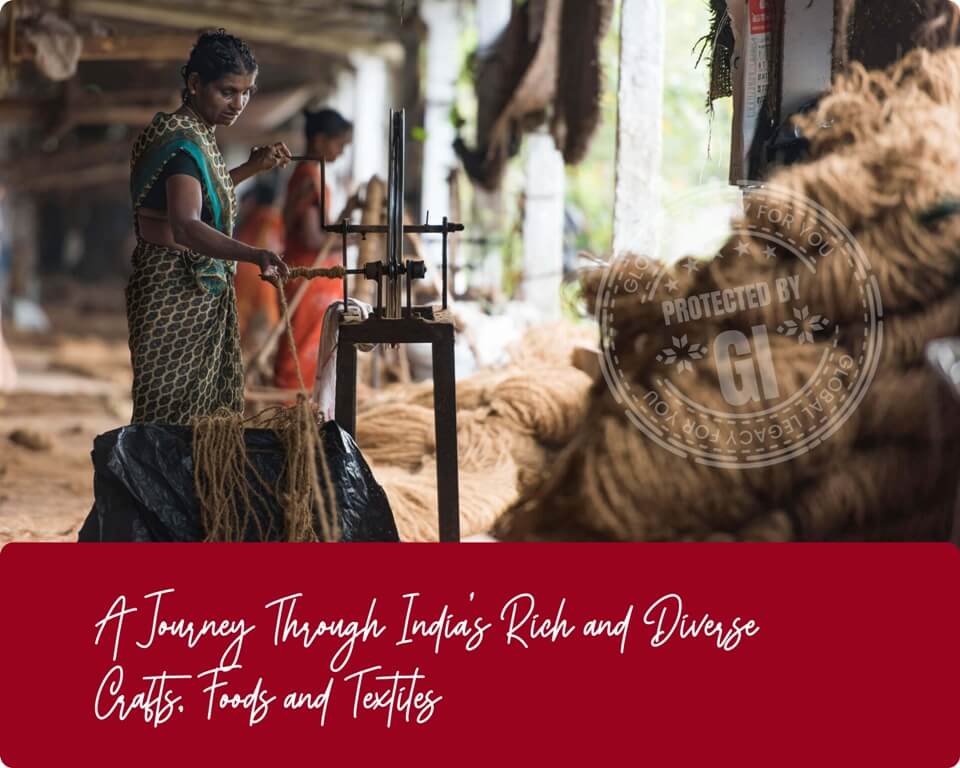
Famous Indian GI Products: Exploring the Diversity of Traditional Crafts, Foods, and Textiles
India is a land of diversity, where culture, traditions, and history blend beautifully to create an incredible tapestry of unique and fascinating customs. One of the most remarkable aspects of Indian culture is its traditional crafts, foods, and textiles, which have earned worldwide acclaim for their distinctive designs and exceptional quality.Over the centuries, Indians have perfected the art of creating high-quality goods that are both beautiful and functional, and these traditional products are regarded not just as beautiful creations but as representation of the country's rich heritage and the artistic talents of its people.
What makes these traditional Indian products so valuable is the craftsmanship involved in their creation. They are produced by skilled artisans who have mastered the techniques over generations and these creations reflect a level of expertise and dedication that is rare and precious. Many of these products have achieved international fame and recognition for their unique features and designs. In this blog, we will explore some of the most famous Inidan GI products, from handloom textiles to delicious regional cuisines and showcase their cultural and economic significance.
Let's start with the textiles. India has a long history of weaving and handloom textiles renowned for their intricate designs and vibrant colors. Some of the most famous handloom textiles from India include Banarasi Silk sarees, Chandheri silk sarees and Kanjeevaram silk sarees. These sarees are made using traditional techniques that have been passed down through generations of weavers. Each saree is a work of art that requires days of meticulous work to create, with intricate designs and patterns inspired by nature. The silk threads, often interwoven with gold, are used to create a fine and delicate fabric that is both beautiful and durable.
Another famous Indian textile is the Pashmina Shawls, a masterpiece made from the wool of the Pashmina goat found only in the Himalayan region of India. These shawls are renowned for their softness, warmth, and exquisite embroidery, which makes them a luxury item that is highly sought afterhighly prized by fashion lovers.
Food is an integral part of Indian culture and GI tagged foods of India tagged foods of India are unique and exceptional products that reflect the cultural heritage and traditional knowledge of the regions they originate from. These products are identified by their distinctive qualities, attributes and reputation that are associated with their geographical origin.
Some of the most famous GI-tagged foods of India include Darjeeling tea, Alphonso mangoes, Basmati rice, Nagpur oranges, Kanchipuram idlis, and Agra petha. Each of these products has a unique story to tell, reflecting the skills and knowledge of local communities and the natural resources of their respective regions. For example, the Darjeeling tea, grown in the Himalayan region, is renowned for its floral aroma and delicate flavor, making it one of the most sought-after teas in the world. Similarly, Alphonso mangoes, grown in the Ratnagiri district of Maharashtra, are known for their sweet, juicy pulp, and distinctive aroma.
India's traditional crafts are equally enchanting. Many of these crafts are made by hand using old age techniques and have been passed down through generations of artisans.One such craft is the Channapatna toy-making craft, which is practiced in the town of Channapatna in Karnataka. These toys are made using lacquer a vegetable dyes and are known for their bright colors and simple designs. They are popular among children and are often used as a decorative item in homes.
In addition to their cultural significance, these traditional crafts, foods, and textiles also have a significant economic impact. Many of these products are produced by small-scale artisans and farmers, who rely on them for their livelihoods. By promoting and supporting these traditional industries, we can help to preserve India's rich cultural heritage and support sustainable economic development.
In conclusion, India's traditional crafts, foods, and textiles are a testament to the country's unique cultural diversity and creativity. From handloom textiles to regional cuisines, and traditional crafts, these products reflect the country's rich history and cultural heritage. By celebrating and promoting these traditional industries, we can help to preserve India's cultural legacy and support sustainable economic development.
Leave A Comment
Your email address will not be published. Required fields are marked *

 INR
INR USD - $
USD - $
 CAD - Can$
CAD - Can$
 EUR - €
EUR - €
 GBP - £
GBP - £
 SGD - S$
SGD - S$
 AUD - A$
AUD - A$
 MYR - (RM)
MYR - (RM)

0 Comment